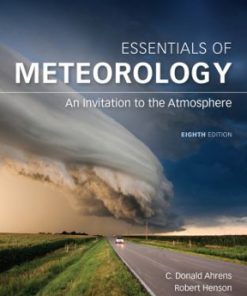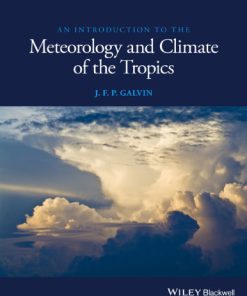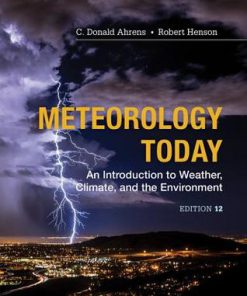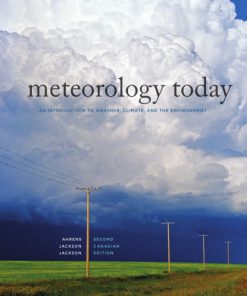Essentials of Meteorology An Invitation to the Atmosphere 8th Edition by C Donald Ahrens, Robert Henson ISBN 1305628454 9798214343099
$50.00 Original price was: $50.00.$25.00Current price is: $25.00.
Essentials of Meteorology An Invitation to the Atmosphere 8th Edition by C Donald Ahrens, Robert Henson – Ebook PDF Instant Download/Delivery: 1305628454, 9798214343099
Full download Essentials of Meteorology An Invitation to the Atmosphere 8th Edition after payment
Product details:
ISBN 10: 1305628454
ISBN 13: 9798214343099
Author: C Donald Ahrens, Robert Henson
ESSENTIALS OF METEOROLOGY: AN INVITATION TO THE ATMOSPHERE is written by the most widely read and authoritative author in introductory meteorology, Donald Ahrens, together with a new coauthor — meteorologist and award-winning science writer Robert Henson. Their ability to explain relatively complicated ideas in a student-friendly way allows both science and nonscience majors to visualize the principles of meteorology. The 8th edition’s clear and inviting narrative is supplemented by pedagogical features that encourage observing, calculating, and synthesizing information, and recent weather and climate events are incorporated to enhance student interest.
Essentials of Meteorology An Invitation to the Atmosphere 8th Table of contents:
Chapter 1. Earth’s Atmosphere
The Atmosphere and the Scientific Method
Weather, Climate, and Meteorology
Meteorology—The Study of the Atmosphere
A Glimpse at a Weather Map
Weather and Climate in Our Lives
Components of Earth’s Atmosphere
The Early Atmosphere
Composition of Today’s Atmosphere
Vertical Structure of the Atmosphere
A Brief Look at Air Pressure and Air Density
Layers of the Atmosphere
Summary
Key Terms
Questions for Review
Questions for Thought and Exploration
Global Geoscience Watch
Chapter 2. Warming and Cooling Earth and Its Atmosphere
Temperature and Heat Transfer
Temperature Scales
Latent Heat—The Hidden Warmth
Conduction
Convection
Radiant Energy
Radiation—Absorption, Emission, and Equilibrium
Selective Absorbers and the Atmospheric Greenhouse Effect
Enhancement of the Greenhouse Effect
Warming the Air from Below
Shortwave Radiation Streaming from the Sun
Earth’s Annual Energy Balance
Why Earth Has Seasons
Seasons in the Northern Hemisphere
Seasons in the Southern Hemisphere
Local Seasonal Variations
Summary
Key Terms
Questions For Review
Questions For Thought and Exploration
Global Geoscience Watch
Chapter 3. Air Temperature
Daily Warming and Cooling Air Near the Surface
Daytime Warming
Extreme High Temperatures
Nighttime Cooling
Cold Air Near the Surface
Protecting Crops from the Cold Night Air
Extreme Low Temperatures
Daily Temperature Variations
Regional Temperature Variations
Applications of Air Temperature Data
Air Temperature and Human Comfort
Measuring Air Temperature
Summary
Key Terms
Questions For Review
Questions For Thought and Exploration
Global Geoscience Watch
Chapter 4. Humidity, Condensation, and Clouds
Circulation of Water in the Atmosphere
Evaporation, Condensation, and Saturation
Humidity
Vapor Pressure
Relative Humidity
Relative Humidity and Dew Point
Relative Humidity and Human Discomfort
Measuring Humidity
Dew and Frost
Fog
Foggy Weather
Clouds
Classification of Clouds
High Clouds
Middle Clouds
Low Clouds
Clouds with Vertical Development
Some Unusual Clouds
Clouds and Satellite Imagery
Summary
Key Terms
Questions For Review
Questions For Thought And Exploration
Global Geoscience Watch
Chapter 5. Cloud Development and Precipitation
Atmospheric Stability
Determining Stability
A Stable Atmosphere
An Unstable Atmosphere
A Conditionally Unstable Atmosphere
Cloud Development and Stability
Convection and Clouds
Topography and Clouds
Precipitation Processes
Collision and Coalescence Process
Ice-Crystal Process
Cloud Seeding and Precipitation
Precipitation in Clouds
Precipitation Types
Rain
Snow
Sleet and Freezing Rain
Snow Grains and Snow Pellets
Hail
Measuring Precipitation
Instruments
Doppler Radar and Precipitation
Summary
Key Terms
Questions for Review
Questions For Thought and Exploration
Global Geoscience Watch
Chapter 6. Air Pressure and Winds
Atmospheric Pressure
Horizontal Pressure Variations—A Tale of Two Cities
Measuring Air Pressure
Pressure Readings
Surface and Upper-Air Charts
Why the Wind Blows
Newton’s Laws of Motion
Forces That Influence the Wind
Straight-Line Flow Aloft
Curved Winds Around Lows and Highs Aloft
Winds on Upper-Level Charts
Surface Winds
Winds and Vertical Air Motions
Determining Wind Direction and Speed
The Influence of Prevailing Winds
Wind Instruments
Summary
Key Terms
Questions for Review
Questions for Thought and Exploration
Global Geoscience Watch
Chapter 7. Atmospheric Circulations
Scales of Atmospheric Motion
Eddies—Big and Small
Local Wind Systems
Thermal Circulations
Sea and Land Breezes
Mountain and Valley Breezes
Katabatic Winds
Chinook (Foehn) Winds
Santa Ana Winds
Desert Winds
Seasonally Changing Winds—The Monsoon
Global Winds
General Circulation of the Atmosphere
Single-Cell Model
Three-Cell Model
Average Surface Winds and Pressure: The Real World
The General Circulation and Precipitation Patterns
Westerly Winds and the Jet Stream
Atmosphere-Ocean Interactions
Global Wind Patterns and Surface Ocean Currents
Winds and Upwelling
El Niño, La Niña, and the Southern Oscillation
Other Atmosphere-Ocean Interactions
Summary
Key Terms
Questions For Review
Questions For Thought
and Exploration
Global Geoscience Watch
Chapter 8. Air Masses, Fronts, and Middle-Latitude Cyclones
Air Masses
Source Regions
Classification
Air Masses of North America
Fronts
Stationary Fronts
Cold Fronts
Warm Fronts
Drylines
Occluded Fronts
Mid-Latitude Cyclonic Storms
Polar Front Theory
Where Do Mid-Latitude Cyclones Tend to Form?
Developing Mid-Latitude Cyclones and Anticyclones
Summary
Key Terms
Questions For Review
Questions For Thought and Exploration
Global Geoscience Watch
Chapter 9. Weather Forecasting
Weather Observations
Acquisition of Weather Information
Weather Forecasting Tools
Weather Forecasting Methods
The Computer and Weather Forecasting: Numerical Weather Prediction
Why Computer-Based Forecasts Can Go Awry and Steps to Improve Them
Other Forecasting Techniques
Time Range of Forecasts
Accuracy and Skill in Weather Forecasting
Weather Forecasting Using Surface Charts
Determining the Movement of Weather Systems
A Forecast for Six Cities
Using Forecasting Tools to Predict the Weather
Help from the 500-mb Chart
The Models Provide Assistance
A Valid Forecast
Satellite and Upper-Air Assistance
A Day of Rain and Wind
Summary
Key Terms
Questions For Review
Questions For Thought and Exploration
Global Geoscience Watch
Chapter 10. Thunderstorms and Tornadoes
Thunderstorms
Ordinary Cell Thunderstorms
Multicell Thunderstorms
Squall-Line Thunderstorms
Supercell Thunderstorms
Thunderstorms and Flooding
Distribution of Thunderstorms
Lightning and Thunder
Tornadoes
Tornado Life Cycle
Tornado Occurrence and Distribution
Tornado Winds
Tornado Outbreaks
Tornado Formation
Supercell Tornadoes
Nonsupercell Tornadoes
Waterspouts
Observing Tornadoes and Severe Weather
Storm Chasing and Mobile Radar
Summary
Key Terms
Questions For Review
Questions For Thought and Exploration
Global Geoscience Watch
Chapter 11. Hurricanes
Tropical Weather
Anatomy of a Hurricane
Hurricane Formation and Dissipation
The Right Environment
The Developing Storm
The Storm Dies Out
Hurricane Stages of Development
Investigating the Storm
Hurricane Movement
Naming Hurricanes and Tropical Storms
Devastating Winds, the Storm Surge, and Flooding
Classifying Hurricane Strength
Hurricane-Spawned Tornadoes
Hurricane Fatalities
Some Notable Hurricanes
Galveston, 1900
New England, 1938
Camille, 1969
Hugo, 1989
Andrew, 1992
Katrina and Rita, 2005
Sandy, 2012
Devastating Tropical Cyclones around the World
Hurricane Watches, and Warnings
Hurricane Forecasting Techniques
Modifying Hurricanes
Summary
Key Terms
Questions For Review
Questions For Thought and Exploration
Global Geoscience Watch
Chapter 12. Global Climate
A World with Many Climates
Global Temperatures
Global Precipitation
Climatic Classification—The Köppen System
The Global Pattern of Climate
Tropical Moist Climates (Group A)
Dry Climates (Group B)
Moist Subtropical Mid-Latitude Climates (Group C)
Moist Continental Climates (Group D)
Polar Climates (Group E)
Highland Climates (Group H)
Summary
Key Terms
Questions For Review
Questions For Thought and Exploration
Global Geoscience Watch
Chapter 13. Earth’s Changing Climate
Reconstructing Past Climates
Climate Throughout the Ages
Temperature Trends During the Past 1000 Years
Temperature Trends During the Past 100-Plus Years
Climate Change Caused by Natural Events
Climate Change: Feedback Mechanisms
Climate Change: Plate Tectonics and Mountain Building
Climate Change: Variations in the Earth’s Orbit
Climate Change: Variations in Solar Output
Climate Change: Atmospheric Particles
Climate Change Caused by Human (Anthropogenic) Activities
Climate Change: Aerosols Injected into the Lower Atmosphere
Climate Change: Greenhouse Gases
Climate Change: Land Use Changes
Climate Change: Global Warming
Recent Global Warming: Perspective
Future Climate Change: Projections
Consequences of Climate Change: The Possibilities
Climate Change: Efforts to Curb
Climate Change: A Final Note
Summary
Key Terms
Questions For Review
Questions For Thought And Exploration
Global Geoscience Watch
Chapter 14. Air Pollution
A Brief History of Air Pollution
Types and Sources of Air Pollutants
Principal Air Pollutants
Ozone in the Troposphere
Air Pollution: Trends and Patterns
Factors That Affect Air Pollution
The Role of the Wind
The Role of Stability and Inversions
The Role of Topography
Severe Air Pollution Potential
Air Pollution and the Urban Environment
Acid Deposition
Summary
Key Terms
Questions For Review
Questions For Thought And Exploration
Global Geoscience Watch
Chapter 15. Light, Color, and Atmospheric Optics
White and Colors
Clouds and Scattered Light
Blue Skies and Hazy Days
Red Suns and Blue Moons
Twinkling, Twilight, and the Green Flash
The Mirage: Seeing Is Not Believing
Halos, Sundogs, and Sun Pillars
Rainbows
Coronas and Cloud Iridescence
Summary
Key Terms
Questions For Review
Questions For Thought and Exploration
Global Geoscience Watch
Appendix A. Units, Conversions, Abbreviations, and Equations
Appendix B. Equations and Constants
Appendix C. Weather Symbols and the Station Model
Appendix D. Average Annual Global Precipitation
Appendix E. Köppen’s Climatic Classification System
Appendix F. Humidity and Dew-Point Tables [Psychrometric Tables]Appendix G. Standard Atmosphere
Appendix H. Beaufort Wind Scale [Over Land]
People also search for Essentials of Meteorology An Invitation to the Atmosphere 8th:
essentials of meteorology an invitation to the atmosphere 9th ed
borrow essentials of meteorology an invitation to the atmosphere
what is the atmosphere in antarctica
essentials of meteorology an invitation to the atmosphere online book
why meteorology is important in aviation
Tags:
C Donald Ahrens,Robert Henson,Essentials,Meteorology,Invitation,Atmosphere
You may also like…
Relationships & Lifestyle - Diet & Nutrition
Politics & Philosophy - Sociology
An Invitation to the Sociology of Emotions Second Edition Scott R Harris
Uncategorized
Earth Sciences
Politics & Philosophy - Anthropology
An Invitation to Feminist Ethics 2nd Edition by Hilde Lindemann 9780190059330 0190059338
Climatology













